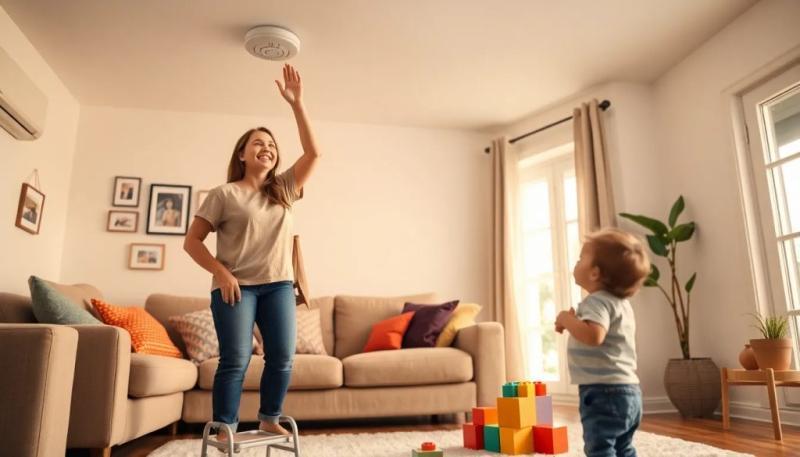As a babysitter, ensuring children's safety and protecting property is paramount. Understanding how babysitters check smoke alarms and exits is a crucial part of this responsibility. In this article, we will explore essential fire safety tips that every babysitter should know.
Fire safety is not just about having extinguishers; it is about being prepared and educated. This guide provides practical advice on fire prevention and how to handle emergencies effectively.
Understanding the importance of fire safety
Fire safety is critical in any household, but it becomes even more vital when caring for children. Understanding the risks associated with fire hazards helps babysitters act proactively.
Children are often unaware of dangers, making it essential for babysitters to recognize potential fire hazards in the environment. Regularly assessing the space for safety risks can prevent accidents before they happen.
Moreover, babysitters are responsible for creating a safe environment. This means not only checking that smoke alarms are functioning but also knowing the layout of the home, including exits and escape routes.
How babysitters check smoke alarms and exits
One of the primary responsibilities of a babysitter is to ensure smoke alarms are operational. This involves a simple yet effective process:
- First, locate the smoke detectors in the home.
- Press the test button on each detector to ensure it sounds.
- Check the dates on the smoke alarms; they should be replaced every ten years.
- Regularly replace batteries, ideally every six months.
In addition to checking smoke alarms, babysitters should familiarize themselves with all exits. Knowing multiple escape routes can be lifesaving.
During your first few minutes in the home, take note of where the exits are located. This knowledge can be crucial in an emergency situation.
Fire prevention measures for babysitters
Babysitters must implement effective fire prevention measures while on duty. Here are some essential tips:
- Ensure that all appliances, such as stoves and irons, are turned off when not in use.
- Keep flammable materials, like paper and cloth, away from heat sources.
- Do not overload electrical outlets.
- Educate children about the dangers of fire and the importance of reporting emergencies.
- Store matches and lighters out of children's reach.
By following these measures, babysitters can significantly reduce the risk of fire incidents. Being vigilant and proactive is essential.
Creating a fire escape plan
A fire escape plan is vital for any household with children. Babysitters should take the time to create a plan that includes:
- Identifying two ways out of every room.
- Choosing a designated meeting spot outside.
- Practicing the escape plan with the children.
It is essential to communicate this plan to the children in a way they can understand. This might include using visuals or role-playing scenarios to ensure they comprehend the steps to take.
Additionally, consider any special needs of the children. Some might require assistance or have specific instructions to follow during an emergency.
Managing a fire emergency
In the event of a fire, the first priority is to ensure the children's safety. Here are some crucial steps to follow:
Do not attempt to extinguish the fire unless it is small and manageable. Instead, your focus should be on getting the children out of the house as quickly and safely as possible.
If smoke is present, keep low to the ground to avoid inhalation. Instruct the children to do the same, guiding them toward the nearest exit.
Once outside, call 911 and do not re-enter the building until emergency services have declared it safe. Alert neighbors if needed to ensure everyone is aware of the situation.
Essential fire safety tips for babysitters
Here are some additional fire safety tips that every babysitter should keep in mind:
- Keep a fire extinguisher accessible and know how to use it.
- Review the home’s fire safety plan with the parents before the babysitting job.
- Conduct fire safety drills regularly with the children.
- Follow up with parents on any safety concerns or improvements needed in their home.
These tips not only ensure the safety of the children but also contribute to a safer overall environment.
Stay safe while babysitting
Babysitting can be a rewarding job, but it comes with responsibilities. Staying informed and prepared is crucial for ensuring the safety of the children in your care.
Always maintain an open line of communication with the parents regarding safety measures and emergency protocols. This can foster trust and ensure everyone is on the same page.
Remember, being proactive about fire safety can significantly reduce risks and enhance the care quality you provide as a babysitter.
Related questions about fire safety for babysitters
What three steps can a babysitter take to be prepared in case there is a fire?
Babysitters should be proactive in their fire preparedness. The first step is to familiarize themselves with the home, including exits, smoke alarm locations, and a fire escape plan.
The second step involves ensuring that smoke alarms are functional and checking that fire extinguishers are accessible and operational. Lastly, practicing a fire drill with the children can help them react calmly in case of an emergency.
How do you check smoke alarms?
Checking smoke alarms is a straightforward process. Start by pressing the test button on the smoke detector to ensure it is operational. If the alarm sounds, it is working correctly. If it does not, replace the batteries and test again.
It is also essential to check the expiry date on the smoke alarm. If it's over ten years old, replace it to ensure maximum safety.
What precautions should a babysitter take with fires or storms?
When babysitting during fire or storm situations, it is important to have emergency contact information readily available. Know the safest routes for evacuation, and keep the children informed about what to do in case of severe weather.
Also, monitor weather updates and inform parents if conditions worsen. Being prepared helps manage risks effectively during these unpredictable situations.
What are the safety rules for babysitting?
Safety rules for babysitters include being aware of emergency procedures, keeping the environment safe, and knowing how to respond in emergencies. Always keep a phone nearby in case of emergencies and avoid distractions while watching the children.
Additionally, establish rules with the children about safety, such as not answering the door to strangers and staying away from hazardous areas like kitchens or garages.




